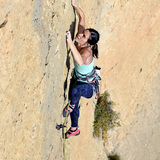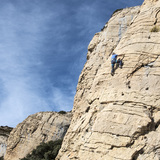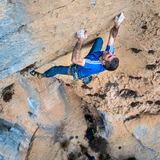Over the last few years, Lleida climber Albert Cortés, aided by his daughter, Laura, has developed two splendid new face-climbing sectors high in the Montsec hills near the zone of Vilanova de Meià.
The first sector — El Mirador del Montsec — actually comprises of three distinct sub-sectors situated on two different levels: the Lower Right, Lower Left (‘Area Privada’) and the Upper Crag (which can itself be split into ‘Left’ and ‘Right’). Collectively, they offer close to one hundred routes on generally excellent rock, ranging in difficulty from grade IV up to 8a, with some harder projects still to be redpointed. The walls range in angle from gentle slab to slightly overhanging and give highly technical face climbing on small holds and horizontal breaks. The situation and outlook are also absolutely stunning! The only negative factor (for some) might be the length of the approaches— 7km of off-road driving followed by between 25 and 35 minutes of uphill walking.
The second sector — Tossal de Les Torretes — lays approximately 3km to the west and is far more limited in scope, offering just 14 climbs ranging from 4c to 6a. However, the rock is immaculate and the situation truly superb, making this a must-visit sector for those operating in the lower grades.
Note: all routes were equipped by Albert Cortés, with some financial assistance from Lleida Climbs.
Orientation — Mirador del Montsec: predominantly south, meaning on cloudless days the crags are exposed to direct sunlight more or less throughout the day. In many nearby zones and sectors that orientation would limit climbing to just a few, short months a year (late autumn to early spring) but in El Mirador del Montsec, situated at altitudes in excess of 1500m, reasonable conditions can often be found anytime outside the very hottest months of mid-summer. It should go without saying that cloudy or windy days in the winter months are not the appropriate time to climb here, and even when the sun is out it’s always a good idea to pack a warm/windproof jacket for belaying.
Orientation — Tossal de Les Torretes: South-east. All the aforementioned comments regarding El Mirador del Montsec and weather conditions also apply here.
Approach — Mirador del Montsec: From the last few houses in the village of Vilanova de Meià, follow the L-913 up towards the main Vilanova sectors (Roca dels Arcs, etc.) but after 3km turn left onto an un-surfaced track, signposted ‘Ermita de Santa Maria de Meià’. Continue driving along the main track for 7km, ignoring a turn off to the right after 500m, signposted ‘Pas de Nerill’ and one to the left after 2km, signposted ‘Ermita de Santa Maria de Meià’, to reach a parking area on the right, just a few metres after a wooden signpost marking the start of the ‘Camí Ramader’ footpath. Note: in dry conditions this track is perfectly drivable in a normal vehicle providing it has reasonable ground clearance, but should not be risked after heavy rains without 4x4 capability.
From the parking area the sectors are clearly visible on the skyline and look disconcertingly far away, but it’s not quite as bad as first appearances suggest. Follow the well-marked ‘Camí de Ramader’ path up the hillside; the first 300m make for an unpleasant warm-up, being rather steep and relentless, but shortly after reaching the tree line the path begins to zigzag and things get progressively easier from thereon. After approximately 25 minutes of walking the lower right-hand sector is reached, via a short trail (cairn where this starts) branching right off the main path. Note: the routes on the right-hand side of this crag are accessed by traversing rightwards from beneath the central part of the sector utilizing fixed ropes.
For ‘Area Privada’: continue along the main ‘Camí de Ramader’ footpath for a further 150m to reach a second cairn, which marks the start of a short trail leading to the right-hand side of the sector (30 minutes from P). Note: the left-hand side of this sector is situated at a higher level and is accessed using a short, vertical Via Ferrata.
For the upper sectors, from the base of the lower right-hand sector, follow a trail directly uphill, leading to the base of the wall. Depending on which part of the cliff you intend to climb on, move either left or right from here (30-35 minutes from the parking area.
Approach — Tossal de Les Torretes: From the main parking areas in the zone of Vilanova de Meià, continue driving up the L-913 to the level area above the gorge. Approximately 300m after the Km 8 signpost there is an unsurfaced track branching off to the right, signposted ‘Toló’. Ignore this, instead continuing along the road for a further 1.7km to the Collada de l’Hostal Roig, where another unsurfaced track branches off to the left. Follow this — in reasonable weather conditions the track is drivable in a ‘normal’ (non 4x4) vehicle, providing it has decent ground clearance, but after heavy rain this may not be the case. Follow the main track, without deviation, for 7.6km to where a smaller, rougher track branches off uphill to the left. Park 350m beyond this at a small clearing, being careful not to block other vehicles. On foot, walk back to the start of the aforementioned sidetrack and follow this uphill for 750m to a flat, grassy area some 50m from the top of the cliffs. Walk directly to the cliff top then follow a narrow terrace down and left (facing out) to reach a short Via Ferrata leading down to the base of the sector (10 min. from P). Note: those with ‘proper’ 4x4 vehicles may actually drive up the final track to the grassy area, thus reducing the approach time to just a couple of minutes.
Water — Mirador del Montsec: There are no water sources at the sector itself, but one can fill up at Font del Manel, beside a circular artificial water reservoir 1 km before the parking area at the start of the ‘Camí Ramader’ footpath, or at Font de La Figuera, which is situated beside the main road L-913 road, approximately 650m beyond the turn-off onto the unsurfaced track that goes towards the sector (Km 3.8).
Water — Tossal de Les Torretes: There are no water sources at the sector itself. The closest spring is Font de La Figuera, which is situated beside the main L-913 road at Km 3.8.








